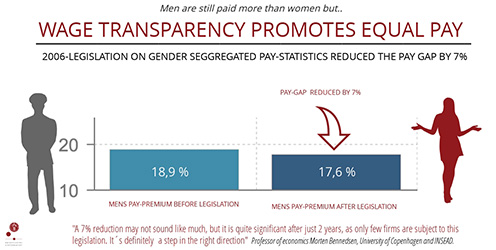Transparency in wage statistics enlarge equality in wage between men and women
The DNRF’s Niels Bohr Professor Morten Bennedsen is in charge of a new analysis that shows how openness in gender-based wage statistics in companies creates more equal wages than in companies that do not have the same transparency. The results also reject the assumption that transparency does not have any significant effect.

The DNRF’s Niels Bohr Professor Morten Bennedsen, from the Economic Institute at the University of Copenhagen and INSEAD Business School, France, together with researchers from Columbia University and the University of North Carolina, is behind new research that shows how companies with transparency in their wage statistics for men and women with the same positions have more gender equality in wages. Also, the results argue against the assumption that transparency in gender-based wage statistics does not have any effect.
In almost all Western countries men are still paid more than women with the same type of position. According to new research led by the DNRF’s Niels Bohr Professor Morten Bennedsen, transparency in gender-based wage statistics for men and women with the same jobs can create more equal wages between them. The debate on whether transparency in such gender-based wage statistics has an effect on wage equality has been going on for several years. Therefore, proposals to force companies to create transparency through disclosure of gender-based wage statistics have often been mentioned as a method for changing wage inequality.
In 2006, the Danish Ministry of Employment decided to introduce rules that oblige all Danish companies with more than 35 employees to publicly disclose wage statistics between men and women with the same job if the company has more than 10 men and women working in the same position. Those who oppose of this initiative argue that transparency in gender-based wage statistics won’t have any significant effect. But Bennedsen and the research team have examined the effect of the rules from 2006, and the result shows that wage transparency works.
“For the first time we are able to document that pay transparency really works."
Morten Bennedsen
Niels Bohr Professor, Department of Economics, University of Copenhagen
The researchers analyzed data from wages between 2003 – 2008 and made a comparative study where they compared wage developments in all Danish companies with 35-50 employees and companies with 25-34 employees. The latter was thus not included by the 2006-rules. The results show that the wage difference is reduced by 7% in those companies that are included by the new rules.
“For the first time we are able to document that pay transparency really works. A 7% reduction in the pay gap may not sound impressive, but given the fact that only a limited number of firms in Denmark are governed by this legislation, the effect is significant. We can even prove the effect among firms that were not required to provide gender-segregated pay statistics. We know now that wage transparency works, and it is a measure that can be applied nationally as well as internationally. So, from this point, it is really just a question of whether or not the politicians actually wish to do something about the pay gap between men and women,” said Niels Bohr Professor Morten Bennedsen, who is the lead author on the study.
Decrease in wages of men
After the 2006 pay transparency rules became effective, male employees were paid an average of 18.9% more than women in similar positions in Danish companies with 35-50 employees. As a part of the research, Bennedsen and his research team made sure that the wage difference was not caused by demographics, seniority, responsibilities, type of work or functions, etc. The 7% reduction in the pay gap occurred in approximately 1000 of the Danish companies that covered under the 2006 rules and was primarily caused by a decrease in the wages of men rather than in the wages of women, after the rules from 2006 became effective.
“We know from other studies that men in general are better at negotiating their salary than most women and that they do not hesitate to demand a higher bonus. But with a forced disclosure of gender-segregated wage statistics the gap between those wages paid by the company to their male and female employees becomes much more clear both internally and externally and it looks like it has made the leaders of the companies slow down the process of raises in male salaries,” said Professor Bennedsen.
The researchers found that the reduction in wage differences varied according to the different companies. Companies that had more external and fewer family board members reduced the pay gap significantly more than 7%. The same was the case where company leaders had more daughters than sons. Moreover, the researchers could show how the pay gap was particularly reduced in industries with a majority of employees of one or the other sex.
Read the analysis in a pre-printed version here.
Read more about the study at the University of Copenhagen here.
